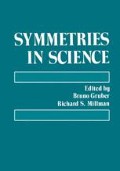Abstract
In recent years, the role of group theory in atomic and molecular physics has stressed interpretation rather than calculation.The trend has thus been to return to the style of the 1930’s after a period in the 1940’s and 1950’s when many problems (for example, the calculation of the term energies of electronic states of the f shell) were made accessible only by means of the technical breakthrough achieved by Racah in his work on Lie groups and their applicability to atomic structure calculations. Modern computing facilities are mainly responsible for this change in attitude. On the other hand, the use of the laser has revealed fine structure in atomic and molecular spectra that make new applications of group theory possible. The detailed example of the vibration-rotation fine structure of SF6 is presented, and the recent work of Harter in this area is reviewed. The usefulness of double tensors, in which the two ranks refer to the frame of the molecule and the frame of the laboratory, is illustrated by the derivation of selection rules for several operators. The peculiar clustering of the fine-structure components is described and related to the triple intersections that Lea, Leask, and Wolf found for the crystal-field splittings of the J levels of rare-earth ions such as Ho3+, for which the ground level possesses a value of 8 for J.
Access this chapter
Tax calculation will be finalised at checkout
Purchases are for personal use only
Preview
Unable to display preview. Download preview PDF.
References
E.P. Wigner, Gruppentheorie, Vieweg u. Sohn, Brunswick (1931).
E.U. Condon and G.H. Shortley, The Theory of Atomic Spectra, Cambridge University Press, New York (1935).
G. Racah, Phys. Rev. 63, 367 (1943).
G. Racah, Phys. Rev. 76, 1352 (1949).
G. Racah, Group Theory and Spectroscopy. Reprinted in Ergebnisse der Exakten Naturwissenschaften, Vol. 37, Springer, New York (1965).
J.P. Elliott, Proc. Roy. Soc. (London) A218, 345 (1953).
L. Armstrong, Jr. and B.R. Judd, Proc. Roy. Soc. (London) A315, 27 and 39 (1970).
B.G. Wybourne, Symmetry Principles and Atomic Spectroscopy, Wiley-Interscience, New York (1970).
A.O. Barut, P. Budini, and C. Fronsdal, Proc. Roy. Soc. (London) A291, 106 (1966);
C. Fronsdal, Phys. Rev. 156, 1665 (1967);
A.O. Barut and H. Kleinert, Phys. Rev. 156, 1541; 157, 1180; 160, 1149 (1967).
V. Fock, Zeits. f. Phys. 98, 145 (1935).
P. Podolsky and L. Pauling, Phys. Rev. 34, 109 (1929).
C. E. Wulfman, Dynamical Groups in Atomic and Molecular Physics.In Group Theory and its Applications (Ed. E.M. Loebl) Vol. II,Academic Press, New York (1971); Chem. Phys. Lett. 23, 370 (1973).
D.R. Herrick, Phys. Rev. Al2, 413 (1975); A17, 1(1978);
D.R. Herrick, and M.E. Kellman, Phys. Rev. A18, 1770 (1978)
K.T. Hecht, J. Mol. Spectros. 5, 355 and 390 (1960)
W.G. Harter, C.W. Patterson, and F. J. da Paixao Rev. Mod. Phys. 50, 37 (1978).
B. Weinstock and G.L. Goodman, Adv. Chem. Phys. 9, 169 (1965)
B.R. Judd, Angular Momentum Theory for Diatomic Molecules,Academic Press, New York (1975).
R.S. McDowell, H.W. Galbraith, G.J. Krohn, C.D. Canterll and,E.D. Hinkley, Optics Comm. 17, 178 (1976).
A.J. Dorney and J.K.G. Watson, J. Mol. Spectros. 42, 135 (1972)
W.G. Harter and C.W. Patterson, Phys. Rev. Lett.38,224,(1977);
J. Chem. Phys. 66, 4872 and 4886 (1977).
K.R. Lea, M.J.M. Leask, and W.P. Wolf, J. Phys.chem.solids 23, 1381 (1962).
Author information
Authors and Affiliations
Editor information
Editors and Affiliations
Rights and permissions
Copyright information
© 1980 Plenum Press, New York
About this chapter
Cite this chapter
Judd, B.R. (1980). Group Theory in Atomic and Molecular Physics. In: Gruber, B., Millman, R.S. (eds) Symmetries in Science. Springer, Boston, MA. https://doi.org/10.1007/978-1-4684-3833-8_10
Download citation
DOI: https://doi.org/10.1007/978-1-4684-3833-8_10
Publisher Name: Springer, Boston, MA
Print ISBN: 978-1-4684-3835-2
Online ISBN: 978-1-4684-3833-8
eBook Packages: Springer Book Archive

